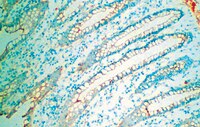Intestinal epithelial wound healing assay in an epithelial-mesenchymal co-culture system.
Seltana, Amira, et al.
Wound Repair Regen, 18: 114-22
2009
Mostrar resumen
Rapid and efficient healing of epithelial damage is critical to the functional integrity of the small intestine. Epithelial repair is a complex process that has largely been studied in cultured epithelium but to a much lesser extent in mucosa. We describe a novel method for the study of wound healing using a co-culture system that combined an intestinal epithelial Caco-2/15 cell monolayer cultured on top of human intestinal myofibroblasts, which together formed a basement membrane-like structure that contained many of the major components found at the epithelial-mesenchymal interface in the human intestine. To investigate the mechanism of restitution, small lesions were generated in epithelial cell monolayers on plastic or in co-cultures without disturbing the underlying mesenchymal layer. Monitoring of wound healing showed that repair was more efficient in Caco-2/15-myofibroblast co-cultures than in Caco-2/15 monolayers and involved the deposition of basement membrane components. Functional experiments showed that the addition of type I collagen or human fibronectin to the culture medium significantly accelerated wound closure on epithelial cell co-cultures. This system may provide a new tool to investigate the mechanisms that regulate wound healing in the intestinal epithelium. | 20082684
 |
Integrin activation by dithiothreitol or Mn2+ induces a ligand-occupied conformation and exposure of a novel NH2-terminal regulatory site on the beta1 integrin chain.
Ni, H, et al.
J. Biol. Chem., 273: 7981-7 (1998)
1998
Mostrar resumen
Integrins can be expressed in at least three functional states (i.e. latent, active, and ligand-occupied). However, the molecular bases for the transitions between these states are unknown. In the present study, changes in the accessibility of several beta1 epitopes (e.g. N29, B44, and B3B11) were used to probe activation-related conformational changes. Dithiothreitol or Mn2+ activation of integrin-mediated adhesion in the human B cell line, IM9, resulted in a marked increase in the exposure of the B44 epitope, while N29 expression levels were most sensitive to dithiothreitol treatment. These results contrasted with the epitope expression patterns of spontaneously adherent K562 cells, where N29 was almost fully accessible and B44 was low. Addition of a soluble ligand resulted in a marked increase in B44 levels, suggesting that this antibody detected a ligand-induced binding site. The N29 epitope was mapped to a cysteine-rich region near the NH2 terminus of the integrin chain, thus defining a novel regulatory site. These studies indicate that the activation of integrin function by different stimuli may involve related but nonidentical conformations. Both Mn2+ and dithiothreitol appear to induce localized conformational changes that mimic a ligand-occupied receptor. This differs from the "physiologically" activated integrins on K562 cells that display a marked increase in overall epitope accessibility without exposure of the ligand-induced binding site epitopes. The increased exposure of the N29 site on K562 cells may indicate a role for this region in the regulation of integrin function. | 9525896
 |












